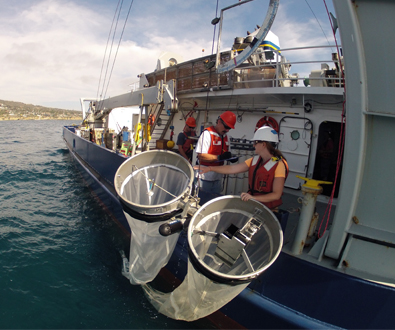
2017년 3월 22일
According to the United Nations, the global population is projected to increase to 9.7 billion people by 2050. With trends like urbanization and climate change limiting places where crops can be grown and livestock can be grazed, maximizing the food supply we can cultivate in water is a critical component to providing a sustainable protein source to millions. Cindy Lawley, PhD, Senior Manager, Market Development explains how Illumina technologies are being used in fisheries management and aquaculture, applications inclusive in what we’re calling “aquagenomics.”
What about commercial fishing? How do Illumina technologies come into play?
Commercial fishing production includes seafood from wild sources offshore or in freshwater. To make it sustainable, the amount caught needs to be carefully managed so that it does not exceed the animals’ natural reproductive capability. This is difficult to do because it’s hard to survey populations in a wild fishery accurately.
Today, fisheries management programs like California Cooperative Oceanic Fisheries Investigations (CalCOFI) use nets to sample ichthyoplankton (larval fish) populations at fixed seasonal stations. They identify and count larval fish by species, and use the data to extrapolate the size of adult populations. The challenge is that only a subset of the ichthyoplankton can be identified by trained experts using traditional visual methods.
Using a DNA barcoding approach, next-generation sequencing (NGS) enables faster and more accurate identification of fish eggs and larvae, allowing more samples to be processed and more complete descriptions of the fish community to be included in fisheries management.
Illumina technologies can also be used to identify the origin of adult fish to improve management. For example, genomic information from Pacific salmonids like King salmon can help trace the fish back to the specific spawning stream or hatchery of origin. This information can be used to understand effects of supplementing the fishery with individuals from hatcheries. It can also provide a feedback mechanism to inform best practices for managing streams.
What about farm-raised fish and seafood? Can Illumina technologies help these markets?
Animals that naturally display the most favorable traits for meat quality, fast growth, and resistance to disease are highly prized within animal husbandry. Fish farming operations are no exception. Broodstock, the fish used for breeding in aquaculture, are especially important because one animal can spawn over a million offspring with similar favorable characteristics. Use of genomics to identify the best candidates for breeding in aquaculture is still in its infancy, but doing so holds the promise of making fish farming more sustainable and profitable. This practice, known as genomic selection, is well-established in higher value animals, like cows and pigs.
While the value of an individual fish is nowhere near the value of a cow or a pig, the value of broodstock families is quite high, and the use of genomic tools on the broodstock shows great promise. The benefits of genomic selection include the ability to select upon multiple traits simultaneously while maintaining diversity of broodstock that persists over many generations.
Today, we see the greatest opportunities in shrimp, prawn, tilapia, salmon, oyster, sea bream, and seabass because these species are commonly farm raised, are being characterized genetically, and have strong initiatives to make them more sustainable and profitable.
What Illumina products are used for this?
Sequencing is used in many ways in aquagenomics. They include, de novo assembly of new aquatic species, discovery of genetic variants (single nucleotide polymorphisms, or SNPs), discovery of linkage between variants and traits of interest, and analyses of the diversity within a given species or population. Sequencing can also be used in metagenomics applications, including fisheries management and population studies described previously. Once key SNPs of interest that capture most of the diversity are identified for traceability and genomic selection, genotyping by sequencing offers powerful approaches for screening samples in a high throughput fashion.
Illumina microarrays can be a cost-effective alternative for genotyping by sequencing, especially for testing high numbers of samples. Illumina works with customers and consortia to develop custom array products with customer-defined content to streamline product development and advance the field.
Recently, Illumina worked with researchers at James Cook University in Australia to identify content for a new ShrimpLD BeadChip, which is now commercially available. The array contains content for use in parentage and pedigree validation testing, genomic selection, and genome-wide association tests.
Image © James R Wilkinson/SIO-CalCOFI


